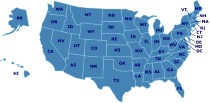Map & Globe Skills
The ability to properly read maps and globes gives you an opportunity to explore different places, people, and cultures in the real world. These resources, teaching tips, and ideas will help make it easy for your children to learn to read and understand maps and globes.
Activities & Experiments
Postcard Kids
Geography Postcard Kids Project started for homeschooled children around the world in October of 2002. It is intended to help enhance geographic studies by sending postcards from their local area to other postcard kids around the world.
Great States Board Game
What is the capital of NJ? Where is the Football Hall of Fame? These are just a few of the hundreds of questions players are asked as they adventure around the USA discovering state attractions and landmarks, capitals, state abbreviations, state locations and more. In order to answer the questions on the cards, players must look closely at the colorful USA map game board, becoming familiar with the geography of the country. Players must hurry to find the answers as the mechanical timer ticks. Contents: Game board, 100 Figure cards, 100 Fact cards, 100 Find cards, 1 spinner, 1 mechanical timer, and game rules. Duration of Play: 20 minutes. 2-6 players.
Name That Country Game
"Dear Pen Pal, Konnichi wa! We've been to see Mt. Fuji. Name my country! Sayonara, Michiko." Challenge your group with this fast-paced geography game, created in 1992 by Educational Insights, Inc. Everyone begins at the post office. Players twirl a finely printed spinner (built into the game board itself) to select one of 60 countries. If the player can correctly identify the country's location on the board's numbered map, he or she may advance along the path to the finish. Bonus moves are won by landing on "postcard" spaces, listening to the clues on one of the 40 postcards, and correctly identifying the pen pal's country. (The sample postcard above came from Japan.) A more challenging game can be achieved by requiring players to name the country's capital; answers are provided. --Liane Thomas
Teaching Tips & Ideas
Knowledge Quest
Knowledge Quest offers historical outline maps and timelines designed for the interactive study of world history and geography.
How I Teach a Large Family in a Relaxed, Classical Way: History
A look at teaching history across several grades using the classical method of education and a rotation of history every four years.
Featured Resources
As an Amazon Associate, we earn from qualifying purchases. We get commissions for purchases made through links on this site.
The Case for Classical Christian Education
Douglas Wilson looks at the state of America's school system and offers a remedy for those who are committed to their children's best interests in education. Wilson details the history of the classical education movement and discusses what is needed for a useful curriculum. Readers will come to understand that classical education offers the best opportunity for academic achievement, character growth, and spiritual education.
The Grammar Of Our Civility: Classical Education In America
This book explains the history of classical education in America and offers a vision for the role of classical education in 21st century America.
Habits: The Mother's Secret to Success (Charlotte Mason Topics - Volume 1)
This work contains a selection of the writings of Charlotte Mason, a British educator. Her writings from the 1880s are still relevant today and contain ideas that can be easily and successfully incorporated into homeschooling. This book focuses on the concept of building good habits in children, why it is important, how it can be implemented, and what impact it will make on home life and homeschooling. Written from a mother's point of view, Mason's works and ideas are explained and distilled int...
A Reason For® Handwriting
A Reason For® Handwriting provides a fun, meaningful approach to developing effective handwriting skills. Each lesson is built around a Scripture verse chosen not only for proper letter combinations, but also inspirational content. “Border Sheets” encourage students to share God's Word with others. You'll find product information about A Reason For® Handwriting here.
Organizing Plain and Simple: A Ready Reference Guide With Hundreds Of Solutions to Your Everyday Clutter Challenges
Desk drowning in papers? No room for the car in the garage? Santa still sitting on the roof in May? A less-is-more philosophy is great, but we all still have way too much stuff. The home office swallows up whole rooms, as does the family computer station. Then there's the home gym, the TV room, and the playroom, not to mention our collections - books, CDs, toys. Time management experts agree that when the minor things that take up space in the mind are eliminated, there is room to think about th...






